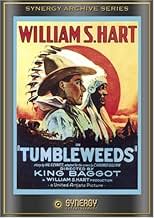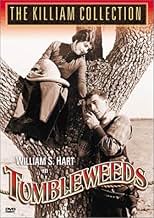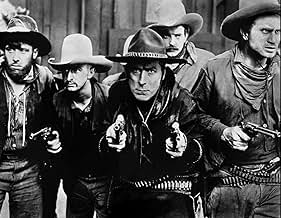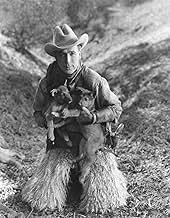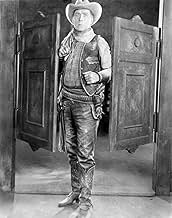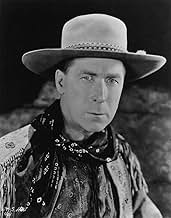The government will grant a fringe of terrain for the settlers who want to live and work there. The starting sign will be a gunshot which will iniciate the run for the best fields and claims... Read allThe government will grant a fringe of terrain for the settlers who want to live and work there. The starting sign will be a gunshot which will iniciate the run for the best fields and claims.The government will grant a fringe of terrain for the settlers who want to live and work there. The starting sign will be a gunshot which will iniciate the run for the best fields and claims.
- Directors
- Writers
- Stars
William S. Hart
- Don Carver
- (as Wm. S. Hart)
- …
Richard Neill
- Bill Freel
- (as Richard R. Niell)
George F. Marion
- Old Man
- (as George Marion)
Taylor N. Duncan
- Cavalry Major
- (as Ted Duncan)
Nora Cecil
- Pioneer Mother
- (uncredited)
Nino Cochise
- Indian
- (uncredited)
Monte Collins
- Hicks
- (uncredited)
Fred Gamble
- Hotel Proprietor
- (uncredited)
George Marion
- Homesteader
- (uncredited)
Apache Bill Russell
- Indian
- (uncredited)
- Directors
- Writers
- All cast & crew
- Production, box office & more at IMDbPro
Featured reviews
Veteran Western film actor William S. Hart was looking for just one more chance to be in a movie. A couple (1915-1916) of the 11 years he appeared in front of the camera, theater owners voted him their biggest money-making star. His schtick was playing the prototype quiet Westerner who dressed plainly. In all of his films his characters went from mostly a bad-behaving gunslinger or ruffian to become the ultimate moralistic hero. But the public wanted flashier cowboys, such as popular Tom Mix, and more action sequences than contained in a typical character-driven Hart film.
His employer, Paramount Pictures, in 1924 elected not to renew his contract, leaving Hart unemployed at age 60. The actor wanted to ride off into the sunset for one last movie. He dug deep into his wallet and produced his final film, one that critics agree was his best one in a relatively long career, December 1925's "Tumbleweeds." Hart hired scriptwriter Hal Evarts to wrap his story around the 1893 Oklahoma land rush and King Baggot to direct.
Hart intended "Tumbleweeds" as his last hurrah with several references within the script that the Old West is gone since the Oklahoma homesteaders were replacing the cowboys he had been portraying on screen. Hart plays the foreman of a big cattle ranch. The United States government during the early 1890s had ordered all large cattle herds to leave the prairie to be replaced by the new settlers who primarily farmed. Likening himself to a tumbleweed, a plant with no roots, he witnesses other herds leaving and says, "Boys, it's the end of the West." Even women can't cox him into settling down as Hart makes the remarkable statement towards the movie's conclusion that "Women ain't reliable-cows are." Carver (Hart) says he's "headed for South America where there's millions of 'em."
Embedded within the high-budgeted $312,000 film, an immense expense in those days for one person to finance, is a specular land rush scene involving almost 1,000 extras, 300 wagons and a number of horses hired to replicate the scene. The 1931 epic "Cimarron," the Academy Awards Best Picture winner that year, copied Hart's chaotic stampede of homesteaders racing to secure the best land they could stake their claim on.
Hart was able to contract United Artists to distribute "Tumbleweeds." But the actor was disappointed, despite the rave reviews the movie was receiving, because the studio didn't place the film into the larger city venues. He sued UA for such a lack of distribution, but settled out of court in 1940. A year before that, on the heels of John Ford's 1938 "Stagecoach," which rejuvenated the Western genre, Hart was asked to provide a prologue to the re-issuance of "Tumbleweeds" with a soundtrack. The 75-year-old retired actor, now a ranch owner in Newhall, California, gave an eight-minute introduction, with his last words, "The saddle is empty, the boys up ahead are calling, they're waiting for you and me to help drive this last great round-up into eternity." Hart rode into his final sunset in June 1946 at 81 years of age at his ranch. The silent Western movie star is buried near his birthplace in Brooklyn, N. Y.'s Green-Wood Cemetery.
His employer, Paramount Pictures, in 1924 elected not to renew his contract, leaving Hart unemployed at age 60. The actor wanted to ride off into the sunset for one last movie. He dug deep into his wallet and produced his final film, one that critics agree was his best one in a relatively long career, December 1925's "Tumbleweeds." Hart hired scriptwriter Hal Evarts to wrap his story around the 1893 Oklahoma land rush and King Baggot to direct.
Hart intended "Tumbleweeds" as his last hurrah with several references within the script that the Old West is gone since the Oklahoma homesteaders were replacing the cowboys he had been portraying on screen. Hart plays the foreman of a big cattle ranch. The United States government during the early 1890s had ordered all large cattle herds to leave the prairie to be replaced by the new settlers who primarily farmed. Likening himself to a tumbleweed, a plant with no roots, he witnesses other herds leaving and says, "Boys, it's the end of the West." Even women can't cox him into settling down as Hart makes the remarkable statement towards the movie's conclusion that "Women ain't reliable-cows are." Carver (Hart) says he's "headed for South America where there's millions of 'em."
Embedded within the high-budgeted $312,000 film, an immense expense in those days for one person to finance, is a specular land rush scene involving almost 1,000 extras, 300 wagons and a number of horses hired to replicate the scene. The 1931 epic "Cimarron," the Academy Awards Best Picture winner that year, copied Hart's chaotic stampede of homesteaders racing to secure the best land they could stake their claim on.
Hart was able to contract United Artists to distribute "Tumbleweeds." But the actor was disappointed, despite the rave reviews the movie was receiving, because the studio didn't place the film into the larger city venues. He sued UA for such a lack of distribution, but settled out of court in 1940. A year before that, on the heels of John Ford's 1938 "Stagecoach," which rejuvenated the Western genre, Hart was asked to provide a prologue to the re-issuance of "Tumbleweeds" with a soundtrack. The 75-year-old retired actor, now a ranch owner in Newhall, California, gave an eight-minute introduction, with his last words, "The saddle is empty, the boys up ahead are calling, they're waiting for you and me to help drive this last great round-up into eternity." Hart rode into his final sunset in June 1946 at 81 years of age at his ranch. The silent Western movie star is buried near his birthplace in Brooklyn, N. Y.'s Green-Wood Cemetery.
Seen in a 16mm print from the 1939 release (not necessarily the 1975 restoration listed by imdb), the sheer sincerity of the film-makers appealed highly. Intelligent art-gallery audience loved it - shown on 40th anni of Hart's death. Sound was coarse (expected) but loud and consistent in quality with image
In the 1939 re-release's introduction, William S. Hart explains, "The story of 'Tumbleweeds' marks one of the greatest epochs of our American history. It tells of the opening of the Cherokee Strip in the year 1889. Twelve hundred square miles of Cherokee Indian lands, on one front, over two hundred miles long, were thrown open by our government to those seeking good earth upon which they might make their homes."
Mr. Hart (as Don Carver) and comic sidekick Lucien Littlefield (as Kentucky Rose) are two of the cattle ranchers who are put out when as the Oklahoman Cherokee Strip is "thrown open" by the government. For Hart, the silver lining comes in the form of a several decades younger sweetheart, homesteader Barbara Bedford (as Molly Lassiter); however, her nasty half-brother J. Gordon Russell (as Noll Lassiter) threatens to spoil the fun. Little brother Jack Murphy (as Bart Lassiter) and his pup have the highest profile relationship that actually works. Still, the film has Hart, and its exciting "land rush!" sequence.
The re-release (which, apart from Hart's cool Shakespearian appearance, is the inferior version, by the way) features the legendary star's farewell:
"My friends, I loved the art of making motion pictures. It is as the breath of life to me no longer a cloud of dust, but a beautiful golden haze through which appears a long phantom herd of trailing cattle. At their head, a Pinto pony with an empty saddle the boys up ahead are calling -- they're waiting for you and me to help drive this last great round-up into eternity
"Adios, amigos. God bless you all, each and every one."
******* Tumbleweeds (12/20/25) King Baggot ~ William S. Hart, Lucien Littlefield, Barbara Bedford
Mr. Hart (as Don Carver) and comic sidekick Lucien Littlefield (as Kentucky Rose) are two of the cattle ranchers who are put out when as the Oklahoman Cherokee Strip is "thrown open" by the government. For Hart, the silver lining comes in the form of a several decades younger sweetheart, homesteader Barbara Bedford (as Molly Lassiter); however, her nasty half-brother J. Gordon Russell (as Noll Lassiter) threatens to spoil the fun. Little brother Jack Murphy (as Bart Lassiter) and his pup have the highest profile relationship that actually works. Still, the film has Hart, and its exciting "land rush!" sequence.
The re-release (which, apart from Hart's cool Shakespearian appearance, is the inferior version, by the way) features the legendary star's farewell:
"My friends, I loved the art of making motion pictures. It is as the breath of life to me no longer a cloud of dust, but a beautiful golden haze through which appears a long phantom herd of trailing cattle. At their head, a Pinto pony with an empty saddle the boys up ahead are calling -- they're waiting for you and me to help drive this last great round-up into eternity
"Adios, amigos. God bless you all, each and every one."
******* Tumbleweeds (12/20/25) King Baggot ~ William S. Hart, Lucien Littlefield, Barbara Bedford
Once it was among the most popular movies of its kind, and now it's generally remembered only by silent movie fans, but "Tumbleweeds" is a classic silent Western that's still worth seeing. To be sure, a lot of its appeal now comes from nostalgia, but in its time it was close to the top of its genre.
The opening scenes start the story nicely, and they also give it some thoughtful overtones, with cowboys Hart and Lucien Littlefield coming to realize their role as "Tumbleweeds" in a changing world. The 'tumbleweed' image is used well in developing Hart's character, as he faces the consequences of the land rush and of the personal affairs he gets involved in. The story itself has a lot of familiar elements, without many surprises, but the atmosphere and the characters are enough to carry it.
The land rush sequence is probably the most exciting part of the movie, and it is quite a fine set piece. It's later followed by a fast-paced climactic chase that also works well. The action makes a good complement to the atmosphere of the changing frontier, making it a movie that fits together nicely, and that still works pretty well.
The opening scenes start the story nicely, and they also give it some thoughtful overtones, with cowboys Hart and Lucien Littlefield coming to realize their role as "Tumbleweeds" in a changing world. The 'tumbleweed' image is used well in developing Hart's character, as he faces the consequences of the land rush and of the personal affairs he gets involved in. The story itself has a lot of familiar elements, without many surprises, but the atmosphere and the characters are enough to carry it.
The land rush sequence is probably the most exciting part of the movie, and it is quite a fine set piece. It's later followed by a fast-paced climactic chase that also works well. The action makes a good complement to the atmosphere of the changing frontier, making it a movie that fits together nicely, and that still works pretty well.
"Tumbleweeds" is a classic of the silent era. It marked the final film in the career of western movie pioneer William S. Hart.
The plot revolves around the Cherokee Land Rush of 1889 Oklahoma where a large tract of land was thrown open to the public for the taking by the American government.
Don Carver (Hart) and his pal Kentucky Rose (Lucien Littlefield) had been earning their living as "tumbleweeds", another name for drifting cowpokes. When the last roundup is completed, they decide to take part in the land rush. Carver meets up with the charming Molly Lassiter (Barbara Bedford) after having had an altercation with her half brother Noll (J. Gordon Russell). Noll teams up with Bill Freel (Richard R. Neill) to acquire a choice ranch section by any means necessary. Turns out that Carver has his sights set on the same ranch which he wants to get for Molly.
The highlight of the film is of course, the land rush sequence. It is marvelously staged by Directors King Baggot and Hart himself. A cast of thousands was employed. A remarkable piece of film making for this or any other time.
The version of the film that is usually shown these days is the 1939 re-issue which had sound effects added, as well as a moving prologue filmed especially for this version. It features Hart coming out of retirement and describing the film and then talking about his career and in effect saying goodbye to all of his fans. He had left films after "Tumbleweeds" following a dispute with the film's distributor.
Hart had always insisted on realism in his films. This had worked in his early films but in the 20s, he had to compete with the more popular films of the flamboyant Tom Mix. He had reached his 60s by this time so he wisely decided to go out on top.
Ohh...the thrill of it all!
The plot revolves around the Cherokee Land Rush of 1889 Oklahoma where a large tract of land was thrown open to the public for the taking by the American government.
Don Carver (Hart) and his pal Kentucky Rose (Lucien Littlefield) had been earning their living as "tumbleweeds", another name for drifting cowpokes. When the last roundup is completed, they decide to take part in the land rush. Carver meets up with the charming Molly Lassiter (Barbara Bedford) after having had an altercation with her half brother Noll (J. Gordon Russell). Noll teams up with Bill Freel (Richard R. Neill) to acquire a choice ranch section by any means necessary. Turns out that Carver has his sights set on the same ranch which he wants to get for Molly.
The highlight of the film is of course, the land rush sequence. It is marvelously staged by Directors King Baggot and Hart himself. A cast of thousands was employed. A remarkable piece of film making for this or any other time.
The version of the film that is usually shown these days is the 1939 re-issue which had sound effects added, as well as a moving prologue filmed especially for this version. It features Hart coming out of retirement and describing the film and then talking about his career and in effect saying goodbye to all of his fans. He had left films after "Tumbleweeds" following a dispute with the film's distributor.
Hart had always insisted on realism in his films. This had worked in his early films but in the 20s, he had to compete with the more popular films of the flamboyant Tom Mix. He had reached his 60s by this time so he wisely decided to go out on top.
Ohh...the thrill of it all!
Did you know
- Trivia(at around 1h 7 mins) Just after the locked-up "Sooners" rush Dan Carver, who is cutting through a rail, the scene shifts to a team of horses pulling a wagon. The right "off" wheeler horse can be seen to go lame but continue running with a noticeable limp.
- Quotes
Don Carver: Boys - it's the last of the West.
- Alternate versionsThe 1939-reissued version was preceded by an eight-minute sound prologue with William S. Hart introducing the film.
- ConnectionsFeatured in The Great Chase (1962)
Details
Box office
- Budget
- $312,000 (estimated)
- Runtime
- 1h 18m(78 min)
- Sound mix
- Aspect ratio
- 1.33 : 1
Contribute to this page
Suggest an edit or add missing content

